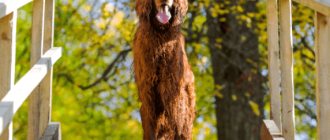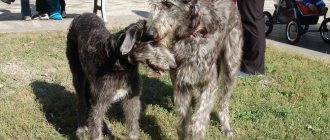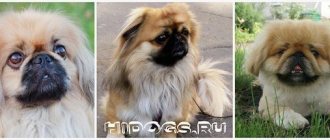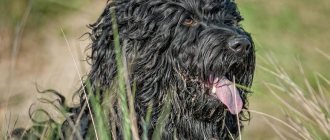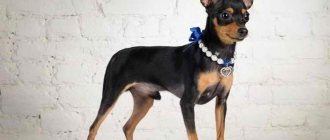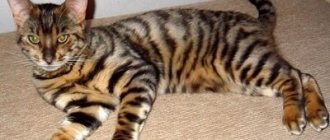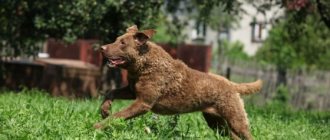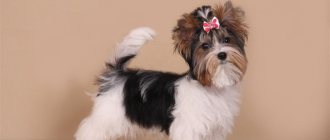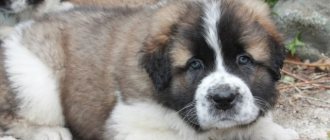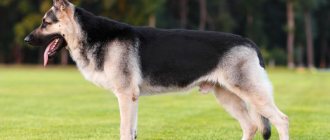Origin story
From the appearance of this dog it is not difficult to guess that its main ancestor is the spaniel. It was the largest representatives of this breed that were crossed with bloodhounds, pointers and other types of hunting dogs that were used for hunting in England and Scotland.
Elegant Scottish Setter
The second name of the breed is Gordon Setter. This is explained by the fact that Duke Alexander Gordon made a huge contribution to the development of the breed. In his castle, he set up a special nursery for breeding Scottish setters.
Interesting Facts
Many hunting breeds are usually divided into working and exhibition breeds. The setter is interesting because it is an exception to the rule. He can simultaneously be a hunter and take part in exhibitions.
An equally interesting fact is that the breed did not become popular, despite many positive characteristics. Back in 1929, the Gordon Setter Club was even created in America, the purpose of which was to popularize this breed. But, unfortunately, Scottish setters did not become popular both in America and throughout the world.
The Scottish Setter is a real beauty and a wonderful hunter
| Breed parameters | |
| Country of origin: | Great Britain |
| Weight of the breed: | males: 25-36 kg, females: 20-32 kg |
| Height at withers: | males: 61-69 cm, females: 58-66 cm |
| Temperament: | active |
| Wool: | average |
| Role in human life: | companion, hunting |
Tolerance of loneliness
History of the breed
Initially, the black and tan setter was bred in Great Britain (Scotland, England) for hunting partridges. Catching small animals and birds is of particular importance to the island's inhabitants.
Previously, the Scotch Terrier (Scottish Terrier) was widely known, specializing in catching foxes and badgers. The typical description of the Scottish Terrier breed is that it is small but robust and has a wheaten or brindle coat.
And yet the dog is unremarkable due to his height.
For hunting, a much more powerful and stubborn breed was required. The hunters understood that tracking down birds would require considerable strength from the dog. The setter had to run and catch prey in marshy areas, mountain hills and hills. It is not difficult to guess that such tricks will require strong limbs and endurance.
The development of the breed was carried out by hunters of medium and small incomes; only later the pets became famous among other segments of the population. Duke A. Gordon played a huge role in breeding, who noticed this favorite and its unusual qualities. The Duke subsequently introduced an improved version of the Scottish dog. The ancestor of the breed is considered to be black and black and tan pointers.
The development work did not end there. Mixings were carried out with Irish setters, spaniels, bloodhounds, and pointers. Outwardly, today's Gordon is most similar to his Irish counterpart. The considerable period from the first appearance to the approval of the breed standard and the description of its exact characteristics indicates long breeding work.
Purpose
English Setter: description of the dog breed
When work on improving the breed was completed, this period occurred at the end of the 19th century, the main purpose of Scottish setters was hunting. Thanks to their excellent sense of smell and endurance, these dogs have become an excellent option for hunters.
The original purpose of the breed is hunting
Due to the fact that in addition to hunting qualities, this dog is also endowed with a friendly character, it is increasingly being kept as a companion. The Scottish Setter is not only loyal to its owner, but also gets along well with all family members.
Breed characteristics
| Short description | |
| Origin: | UK, Scotland |
| Conditions of detention: | House with or without garden |
| Purpose: | Hunting dog (gun dog), companion dog |
| Color: | Black and Tan |
| Wool length: | Long |
| Adult dog size: | The height of the female is 62 cm, the male is 65 cm; male weight – 29.5 kg, female – 25.5 kg |
| Average life expectancy: | 10-13 years |
| Walk: | Walking twice a day is required |
| Physical activity needs: | High physical activity needs (1.5-2 hours of active walking or training per day) |
| Fédération Cynologique Internationale (FIC) classification: | Group 7: Pointers, Section 2: British and Irish Pointers and Setters |
| Puppy price: | From 10 to 35 thousand rubles. Without pedigree - 10-12 thousand rubles, pet class - up to 20 thousand rubles, breed class - up to 28 thousand rubles, show class - 35 thousand rubles |
Appearance
There is a specific breed standard, which was officially adopted in 1988. It implies a number of characteristics regarding the appearance of a Scottish Setter dog.
| Body type | The maximum weight of an adult dog is 30 kg, weight 65 cm. The body is massive and muscular. The back and tail are straight. The neck is of medium length. |
| Head | Quite large. Flat between the ears, it blends smoothly into a square muzzle. Scissor bite, white teeth, wide and black nose. |
| Ears, eyes | Hanging and long, close to the head. Covered with wool. |
| Wool, color | The length of the coat is not uniform; it is longer on the neck, belly and legs than on the body. Soft to the touch, medium length, slightly wavy. Usually the setter is black, part of the muzzle, paws and chest have a characteristic red color. |
Setter (dog): description of the Russian breed, types
It is by these parameters that they determine how purebred the Gordon Setter is. The dog is very graceful in appearance. If the color is not tan or white, it may be a mixed breed.
Important! In the breed, there is a strong difference in weight and size between individuals of opposite sexes.
Sometimes the weight and height of females is significantly less than that of males.
Distinctive features
This is the largest among the Setters, similar in appearance to the English and Irish, but much more powerful and taller . Dogs can reach 65 cm at the withers, and their weight is 25-29 kg . The breed is muscular, with strong limbs and bone structure. A distinctive feature is the long wavy coat, which is characterized by a single color - black and tan.
- The head is voluminous, dry, with a pronounced stop , flat between the ears.
- The muzzle is equal in length to the skull, square, with a straight back of the nose. The lips are soft, fleshy, the upper one is much larger than the lower one, and droops slightly. bite (the upper teeth overlap the lower teeth);
- The nose is wide, black, with open nostrils;
- The eyes are medium-sized, widely set, dark brown in color; the look is a little sad due to the drooping upper eyelid;
- The ears are long, thin, wide. Set at eye level, hanging down and close to the head;
- The body is stretched, muscular and heavy. The topline slopes slightly from the withers to the horizontal croup. The withers are pronounced. The stomach is tucked. The neck is long and wide. The chest is wide and well let down.
- The tail is a continuation of the lower back, set low, hangs down when calm, not long and thick. When active, it does not rise above the croup.
- Limbs are straight, dry, parallel and widely spaced. The paws are round with clenched toes. The movements are sweeping and free.
- The coat is long, wavy, thick, shiny, soft. Forms feathering on the ears, tail, underline, and back surface of the limbs.
- The color is black and tan, white markings on the chest are allowed, but are considered undesirable.
Character and training
American Bandog: description of the dog breed
Before you become the happy owner of a Scottish Setter, it is worth considering some of the character traits of this dog. There are several important points:
- The breed is stubborn, so you need to start training as early as possible;
- the dog will become a real adult only after 2-3 years, and before that he will behave like a puppy;
- These dogs become very attached to their owner and do not tolerate loneliness well.
These character traits of the Scottish Setter play an important role in the upbringing and maintenance of the pet. It is worth taking into account not only the friendly disposition of the dog, but also the characteristics of its disposition and behavior.
The Gordon Setter dog breed is highly trainable. The only thing that can complicate the work is the stubbornness and restlessness of the puppies. You need to start training as early as possible and then there will be no problems with an adult dog.
Scottish Setter: 75 photos, price, history and detailed description of the breed
The Scottish Setter is a breed bred for hunting. It is also called the Gordon Setter.
Dogs of this breed are hardy and have an excellent sense of smell, thanks to which they can find prey even in hard-to-reach areas.
Also, the Scottish Setter Gordon can be attributed to such qualities as: ease of training, strength, excellent instincts, balanced character and excellent consistency of work during the hunt.
History of the breed
The ancestry of the Scottish Setter originates from black pointing dogs, they were common in the north of Scotland. The second name Gordon was given in honor of a representative of the noble family, Alexander Gordon. He organized a huge nursery in his own castle.
It is believed that setters once descended from spaniels. There were different species, which were distinguished by their method of hunting.
The setting spaniel carefully stalked up to the bird and then made a stance. This species began to gain popularity, and they began to cross it with other breeds of hunting dogs.
The new type was simply called the setter, as it began to differ significantly from spaniels.\
Alexander Gordon standardized the color and helped popularize the breed. Today these dogs are bred in different countries of the world.
Hunting qualities
Dogs of this breed enthusiastically hunt in any area:
- In the woods;
- on the fields;
- in water places;
- in the swamps.
The dog is tireless in the literal sense of the word, he will bleed his paws, but will pursue his victim. However, such single-mindedness can bring a number of problems. So Gordon can seriously injure his paws on the reeds, injure them, stretch his muscles, and get hypothermia. Therefore, daily training and loads are important, regardless of the time of year and weather conditions.
As soon as the puppy receives the vaccine, training can begin. First of all, these are the basic commands. After this, the dog is taught not to be afraid of shooting from a gun, to float on the water and maintain restraint in unforeseen situations.
Once the calling commands and other basic exercises have been mastered, the Gordon is taught to track and grab a bird. Most often, quails that are released from the cage are used for these purposes.
At the same time, the dog should not show obvious aggression and try to kill the game.
Description of the breed
The dog has an amazing exterior and good hunting qualities. A description of the Scottish Setter breed will allow you to learn more about the breed.
A large dog with strong bones and a short tail. A small head with a long muzzle is located on a thin neck.
The animal has large eyes and long hanging ears. This breed has medium-length hair that does not hinder movement. It can be smooth or slightly wavy.
The fur of the same length covers the entire body, but is shorter on the paws and muzzle. The black and tan coloring distinguishes this breed from other setters.
How to avoid getting scammed
When buying, they often deceive - they slip in beautiful photographs, replace puppies, falsify documents. A common scheme is with a deposit, when the seller requires it to be transferred to the card. The dog may not be vaccinated, check the vaccination records. Carefully examine the dog and check the documents, do not give the money in advance, even partially.
Take the Attention Test! Find 10 differences! (click right here!)
Find the answer Are you bothered by some problem or question? Enter “Breed” or “Name of the problem” into the form, press Enter and you will find out everything about the issue that interests you.
Character
A calm and reasonable animal with intelligent eyes becomes strongly attached to its owner. It is wary of strangers. A dog can protect a child, but you should not leave the baby alone with it.
The Scottish Setter has no aggression towards other animals. Therefore, with good upbringing, he is able to get along even with a cat in the same house.
The animal finds a common language with other dogs, conflicts rarely arise.
Representatives of this breed are trainable. They will listen to a person they truly respect.
Before adopting a dog from the kennel
Any pet with character and emotions. Call a friend who already has an animal if you have not interacted with animals. Relatives may have a negative attitude towards the decision to adopt a dog - convince them and get their consent.
Walk the dog yourself, or arrange with relatives. Remember, the dog is usually walked 3 times a day. If you have children, they should be able to get along with animals. Teach them not to hurt your pet.
The child should not touch the pet when she is eating or sleeping. You cannot scare or shout at the animal.
Health
Gordons rarely get sick, they have excellent immunity. They live up to 10-12 years, but have a predisposition to certain ailments.
Heavy weight can lead to joint problems. Many dogs suffer from eye diseases. To avoid bloating in your pet, you need to feed him fractionally.
Long floppy ears may cause your dog to suffer from otitis media. Hygiene measures will help prevent this.
Training
The Scottish Setter has high intelligence and excellent memory. He quickly learns commands and is relatively easy to learn and train. At the same time, he can be stubborn and impatient. The owner should show restraint and patience. Persistently repeat the command and be sure to achieve its execution.
You shouldn’t shout at Gordon; the owner’s intonation should be demanding, but calm, and his tone should be friendly.
After completing the command correctly, praise the puppy. You can start training commands at three months: on your own or in a kennel club.
Price
If you buy an animal from a nursery, the average cost will be 35,000 rubles. If you need a grown-up pet that has managed to show itself, then the price of a Scottish Setter will be higher.
The cost of a dog may increase if the puppy is from a litter with imported sires. You can purchase a home-bred animal. It will cost about 10 thousand rubles.
The first thing to do
Plan when you will take your dog for vaccinations. Bring toys for him to play with. Prepare a place and train your pet to this place. Necessary things:
- Dry food,
- clothes,
- Shampoo,
- Oral hygiene product,
- Brush (comb),
- Claw clipper.
If you want to add your organization, fill out the form below: Indicate the name of the nursery, its description and provide contact information. We will be glad to add you to our directory.
Rules of care
In addition to the general requirements for caring for a dog, such as treatment for parasites and timely vaccination, there are two important points. They are due to the fact that the Scottish Setter has long ears and hair.
Ears
Due to the fact that the breed is endowed with hanging ears, they need to be cleaned and inspected regularly. For cleaning, use special solutions that can be purchased at a pet store.
Attention! If during examination any changes in the appearance of the auricle or discharge are detected, you should immediately contact a veterinarian.
Wool
The Gordon Setter is not smooth-haired at all. Long and soft hair obliges the owner to regularly comb, bathe and cut the dog.
There is no need to bathe your pet often; it is enough to carry out this procedure 2-3 times a year or when absolutely necessary. But you need to comb it at least once a week.
Long hair requires care
Health and life expectancy
In general, the Scottish Setter is a strong, hardy dog. There are some genetic diseases in the breed, but most of them are not life-threatening.
- Hip dysplasia;
- Cataract;
- Progressive retinal atrophy;
- Hypothyroidism;
- Dogs with low chests are susceptible to volvulus.
To maintain Gordon's health, it is necessary to take a responsible approach to the issue of disease prevention, which includes timely vaccination and treatment against external and internal parasites. A huge problem for working hunting dogs is piroplasmosis, which the animal becomes infected with a tick bite.
Given the specific nature of their work, setters rarely suffer serious injuries while hunting. Usually everything is limited to cuts, scratches, and in rare cases, dislocations or sprains. Life expectancy is usually 11-13 years
Breeding Features
If the plans of the owner of a Scottish Setter include not only keeping one dog, but also breeding this beautiful breed, then it is worth considering some points regarding mating and keeping puppies.
Mating
The bitch is ready for mating only after she is 2-3 years old. Early pregnancy and childbirth may negatively affect her health.
For mating, it is better to choose a partner from the nursery. This will not only guarantee that you will receive puppies with a pedigree, but will also provide assistance from professional breeders.
Puppies
A place for keeping small setters must be prepared in advance. It should be warm, dry and protected from drafts.
Small pets need to be examined daily.
Attention! If you have no experience in childbirth, it is better to invite a veterinarian to do this.
Hunting
Scottish Setters are often used for hunting. Dogs work persistently and efficiently in forest areas, fields, ponds and swamps. Gordon is tireless in the literal sense of the word, he will make his paws bleed, but will move on. The main problem lies in the determination of Scottish setters: the dog cuts its paws on the reeds, gets injured, strains its muscles, gets hypothermic, but it works! This is one of the main reasons that the four-legged dog must receive daily, serious stress at any time of the year and regardless of weather conditions.
Training for working setters begins immediately after receiving vaccinations. First of all, the four-legged animal is taught basic commands. Further, the dog learns not to be afraid of shots, to swim and to remain calm in extreme situations. Only after practicing calling and basic commands is a grown-up setter taught to track and pick up a bird. Usually, in training they use quails that are released from the shelter. The dog should not show obvious aggression towards the bird or try to kill it.
Important! Only a purebred (with a pedigree) dog can receive permission to hunt, after registering with the hunting establishment and passing working tests.
Advantages and disadvantages
Like every breed, Scottish Setters have both advantages and disadvantages.
The advantages include:
- friendly disposition;
- devotion to the owner;
- good health;
- ability to get along with children and other pets;
- high intelligence;
- excellent exterior.
Disadvantages are difficult to find, but they exist:
- daily walks of at least 1-2 hours are required;
- long hair requires care;
- prone to running away and digging tunnels.
Considering the pros and cons of the breed, we can conclude that it is better to keep such a dog in a private home.
Need long daily walks
In apartment conditions, the Scottish Setter requires increased attention and long walks. When choosing a dog, you must take into account the requirements and conditions that it needs.
Description
- the breed has strong bones and developed large muscles, which contributes to the weight of the cable over 30 kg, and the bitches from 25 to 30 kg;
- the cable height reaches from 60 to 70 centimeters, and the bitch reaches 67 cm; if the pet does not reach this criterion, it means that she can be disqualified, which does not give her the right to register offspring;
- the neck is not massive, the head is not large;
- the breed has developed limbs that are long and dexterous;
- There are a huge number of olfactory receptors located on the dog’s face, which help to hunt in any conditions;
- the tail is long, thick at the base, and then decreases;
- the breed is a smooth-haired pet;
- ears hanging, in the shape of a triangle;
- lifespan from 12 to 16 years;
- the breed has only black color, so that the transition to tan is clear, you cannot have at least some deviation from the color, otherwise the dog will be disqualified;
- Eye color is brown, the shape looks like an almond or round.
To confirm the above, below is a photo of a Scottish Setter.
Selection and cost of a puppy
Becoming the owner of a Scottish Setter with a good pedigree is not so easy. The difficulty is that the breed is not particularly popular and there are not many nurseries and breeders who breed it.
The choice of a puppy itself involves a number of sequential actions:
- Choosing a nursery or breeder.
- Studying the pedigree of puppies.
- Choosing a puppy in the kennel.
Attention! The last point involves assessing not only the appearance of the future pet, but also observing its behavior.
It is better to take puppies from a kennel
The cost of Scottish Setter puppies depends on the breeder and pedigree. The starting price is 10 thousand rubles.
How to choose a puppy
Gordons are not a popular breed, so acquiring one can be a challenge. The nursery will provide the necessary documents, the breeder will provide information about the parents, content, and breed diseases. In addition, he will help you decide on a puppy and recommend a brand of food and hygiene products.
The cost of a pet directly depends on its class and age.
- Pet class – puppies with slight deviations from the standard – is the cheapest option.
- Breeding class – dogs suitable for breeding.
- The most expensive - show class - show pets.
If a dog is purchased at the age of 6-12 months, it will also cost more. The pet will be trained in commands and will undergo some kind of field testing, which means that it is easy to determine its working qualities.
Setter puppies are always active and curious. The price varies from 10 to 35 thousand rubles.
Scottish Setters are not domestic animals. These are serious, strong dogs designed for hunting and working. They have not yet lost their working qualities and are valued as weapons. Therefore, before getting such a pet, you need to think about the possibilities and conditions for keeping it.
Choosing a nickname
The Scottish Setter is a dog with an aristocratic and elegant appearance. Simple names are not suitable for such a dog; it is better to choose a beautiful English nickname. A clue may be the name listed in the pedigree.
Unfortunately, the Scottish Setter breed is not a leader in popularity. The noble appearance and friendly disposition of these dogs allows us to conclude that this is completely undeserved. For an energetic owner, such a pet will be an excellent walking companion and a loyal friend.

